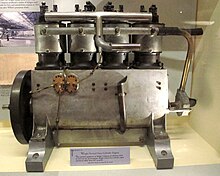
Wright Vertical 4
| Wright Vertical 4 | |
|---|---|

| |
| Wright Vertical 4 aircraft engine on display at the Steven F. Udvar-Hazy Center. This particular engine was used on the Wright B-1 seaplane that crashed in 1912. A patch was bolted to the side of the crankcase in an attempt to repair the engine. | |
| Type | Liquid-cooled inline-4 piston aero engine |
| National origin | United States |
| Manufacturer | Wright Company |
| Designer | Orville Wright |
| Major applications | Wright Model A Wright Model B |
| Number built | around 100[1][2] |
The Wright Vertical 4 was an American aircraft engine built by the Wright brothers in the very early years of powered flight. It was a liquid-cooled piston engine with four inline cylinders, mounted vertically. (Earlier Wright engines were mounted horizontally.) It generated about 30–40 horsepower (22–30 kW) from a displacement of 240 cubic inches (3.9 liters) and weighed about 160–180 pounds (73–82 kg). Developed by Orville Wright in 1906, the Vertical 4 was produced by the Wright Company until 1912 and was the most numerous engine they manufactured.[3][4] Around a hundred Vertical 4 engines were built, according to a Wright test foreman.[1][2]

The Vertical 4 powered most Wright aircraft during this period, including the Model A and Model B and variants built for the U.S. Army and Navy.

This engine was also built under license by Bariquand et Marre in France and by Neue Automobil-Gesellschaft in Germany.[5][2]


Applications

Engines on display
Wright Vertical 4 engines can be seen on display in the following museums, among others:

- National Air and Space Museum, Washington, D.C.
- Steven F. Udvar-Hazy Center, Chantilly, Virginia
- Wright Brothers Aviation Center in Carillon Historical Park, Dayton, Ohio
- Hiller Aviation Museum, San Carlos, California
- New England Air Museum, Windsor Locks, Connecticut
- Museum of Science and Industry, Chicago, Illinois
- National Museum of Flight, East Fortune, Scotland
Specifications

Data from "Wright Vertical 4, In-line 4 Engine (inventory A19620037000)". Smithsonian National Air and Space Museum. Retrieved 12 June 2018.

General characteristics
- Type: 4-cylinder, liquid-cooled inline piston aircraft engine
- Bore: 4.375 in (111 mm)
- Stroke: 4 in (102 mm)
- Displacement: 240 in3 (3.9 L)
- Length: 40.75 in (1,035 mm)
- Width: 18 in (457 mm)
- Height: 27 in (686 mm)
- Dry weight: 160–180 lb (70–80 kg)[6][4]
- Designer: Orville Wright
Components
- Valvetrain: overhead valve, two valves per cylinder, "automatic" intake valve (driven by suction), exhaust valve actuated by camshaft and pushrod
- Cooling system: liquid-cooled
Performance

References
- This article contains material that originally came from the placard at the Steven F. Udvar-Hazy Center.
Bibliography
Hobbs, Leonard S. (1971). Smithsonian Annals of Flight, No. 5: The Wright Brothers' Engines and Their Design (PDF). Washington, D.C.: Smithsonian Institution Press.

Lippincott, Harvey H. (1987). "Propulsion Systems of the Wright Brothers". In Wolko, Howard S. (ed.). The Wright Flyer: An Engineering Perspective. Washington, D.C.: Smithsonian Institution Press. pp. 87–89. ISBN 0-87474-979-4.

McFarland, Marvin W., ed. (1953). The Papers of Wilbur and Orville Wright, Including the Chanute-Wright Letters and Other Papers of Octave Chanute. Vol. Two: 1906–1948. New York: McGraw-Hill. pp. 1215–1216.

External links
- "Wright Vertical 4, In-line 4 Engine". Smithsonian National Air and Space Museum. Retrieved 8 June 2018. (Former keepsake of Orville Wright, inventory A19620037000.)
- "Wright Vertical 4, In-line 4 Engine". Smithsonian National Air and Space Museum. Retrieved 8 June 2018. (U.S. Navy Wright Model B engine, inventory A19520108000.)
- "1906-1912 Wright 4-40 Engine". www.wright-brothers.org. Retrieved 9 June 2018. Further detail on the engine's construction and history, and pointers to references.
See what we do next...
OR
By submitting your email or phone number, you're giving mschf permission to send you email and/or recurring marketing texts. Data rates may apply. Text stop to cancel, help for help.
Success: You're subscribed now !
